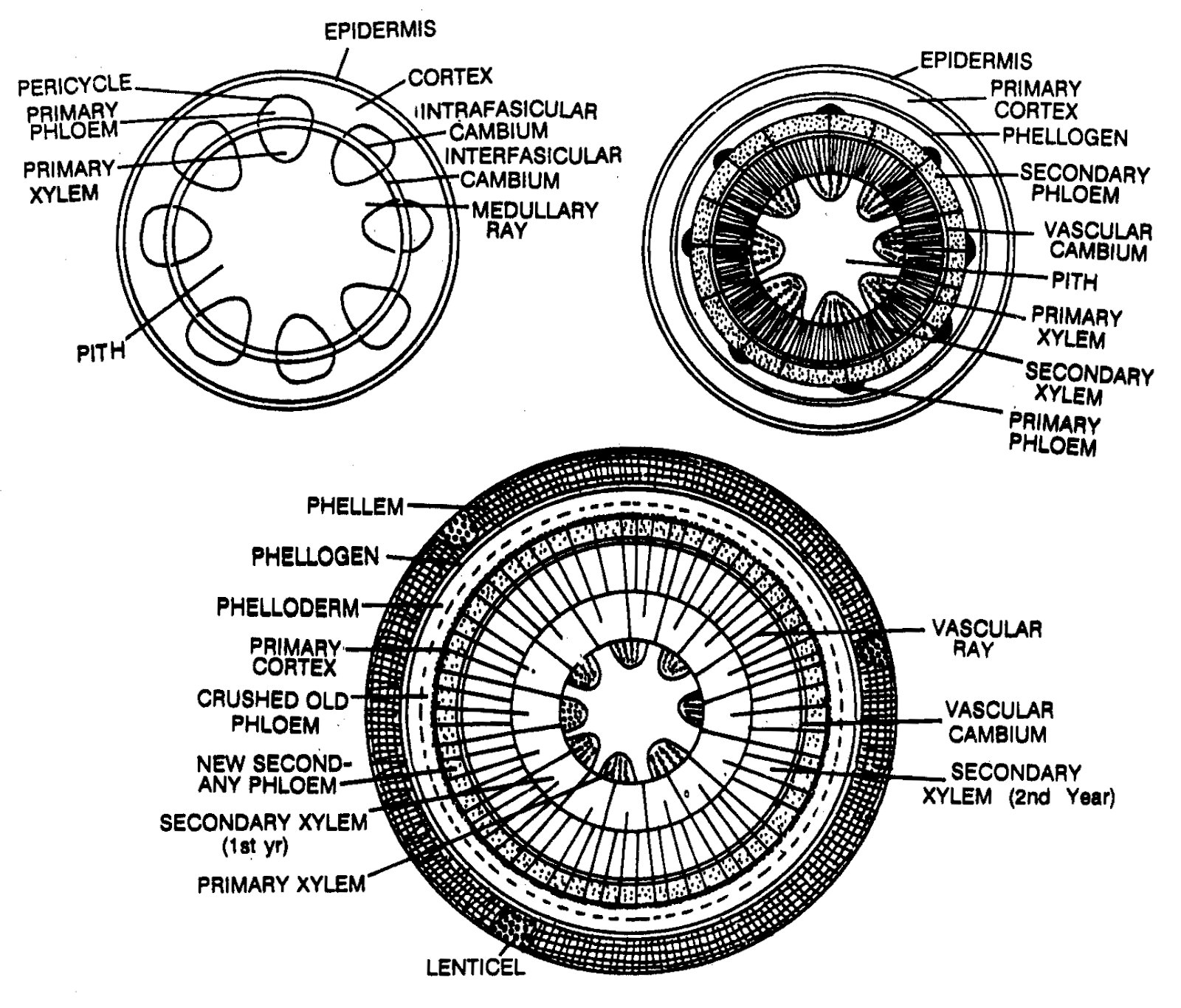
Explain the process of secondary growth in the stelar region of dicot stem.
Answer
589.8k+ views
Hint: Secondary growth in the stelar region occurs because of the activity of the vascular cambium.
Complete answer:
Secondary growth in the dicot stem’s stelar region is a complex process. It occurs because of the activity of the vascular cambium, which is composed of fusiform cells and ray cells. The fusiform cells divide to form two daughter cells, one of which remains as the cambium, the other one forms phloem element or xylem element. If they are produced outwards the phloem element is formed, and if produced inwards, the xylem element is formed. The ray cells cut the parenchymatous cells both inwards and outwards forming secondary medullary rays. As this secondary growth continues, the primary tissues present outside the secondary vascular tissues; primary phloem, cortex and epidermis are pushed outside as they are subjected to pressure from inside by the growing secondary vascular cylinder and eventually crushed off. The primary xylem persists and can be seen inner to the secondary vascular cylinder. The secondary xylem formed shows two different alignments, axial and radial. They form the bulk of vascular tissue in woody plants. The activity of the cambium ring is not uniform throughout the year. During the spring season, the vascular cambium is active, leading to a high amount of xylem element formation, whereas in autumn more phloem is formed. So per year each ring consists of a ring of spring wood and a circle of autumn wood. Over the years as secondary growth continues, the secondary xylem grows and becomes darker and darker. The inner part which is dark is called the heartwood or duramen, whereas the outer lighter part is the sapwood or alburnum. The cells of heartwood are dead and form raisins, gum or tanin, whereas the sapwood is composed of living cells which perform conduction. As the plant grows older, rings of sapwood bordering heartwood keep on converting into heartwood. This is a gradual slow process during which the living cells of sapwood lose their protoplast, vessels are blocked by tyloses and there is impregnation of substances like gums, tannin, suberin, etc.

Notes:
> Secondary xylem is commonly known as the wood.
> Spring wood is lighter than autumn wood, and can be distinctly identified.
> Dendrochronology is the study of determination of the age of the tree by counting the rings of sapwood and heartwood.
> In dicot stems, vascular bundles are open, conjoint and present in a ring like manner.
Complete answer:
Secondary growth in the dicot stem’s stelar region is a complex process. It occurs because of the activity of the vascular cambium, which is composed of fusiform cells and ray cells. The fusiform cells divide to form two daughter cells, one of which remains as the cambium, the other one forms phloem element or xylem element. If they are produced outwards the phloem element is formed, and if produced inwards, the xylem element is formed. The ray cells cut the parenchymatous cells both inwards and outwards forming secondary medullary rays. As this secondary growth continues, the primary tissues present outside the secondary vascular tissues; primary phloem, cortex and epidermis are pushed outside as they are subjected to pressure from inside by the growing secondary vascular cylinder and eventually crushed off. The primary xylem persists and can be seen inner to the secondary vascular cylinder. The secondary xylem formed shows two different alignments, axial and radial. They form the bulk of vascular tissue in woody plants. The activity of the cambium ring is not uniform throughout the year. During the spring season, the vascular cambium is active, leading to a high amount of xylem element formation, whereas in autumn more phloem is formed. So per year each ring consists of a ring of spring wood and a circle of autumn wood. Over the years as secondary growth continues, the secondary xylem grows and becomes darker and darker. The inner part which is dark is called the heartwood or duramen, whereas the outer lighter part is the sapwood or alburnum. The cells of heartwood are dead and form raisins, gum or tanin, whereas the sapwood is composed of living cells which perform conduction. As the plant grows older, rings of sapwood bordering heartwood keep on converting into heartwood. This is a gradual slow process during which the living cells of sapwood lose their protoplast, vessels are blocked by tyloses and there is impregnation of substances like gums, tannin, suberin, etc.

Notes:
> Secondary xylem is commonly known as the wood.
> Spring wood is lighter than autumn wood, and can be distinctly identified.
> Dendrochronology is the study of determination of the age of the tree by counting the rings of sapwood and heartwood.
> In dicot stems, vascular bundles are open, conjoint and present in a ring like manner.
Recently Updated Pages
Master Class 11 Economics: Engaging Questions & Answers for Success

Master Class 11 English: Engaging Questions & Answers for Success

Master Class 11 Social Science: Engaging Questions & Answers for Success

Master Class 11 Biology: Engaging Questions & Answers for Success

Class 11 Question and Answer - Your Ultimate Solutions Guide

Master Class 11 Business Studies: Engaging Questions & Answers for Success

Trending doubts
10 examples of friction in our daily life

One Metric ton is equal to kg A 10000 B 1000 C 100 class 11 physics CBSE

Difference Between Prokaryotic Cells and Eukaryotic Cells

1 Quintal is equal to a 110 kg b 10 kg c 100kg d 1000 class 11 physics CBSE

State the laws of reflection of light

Explain zero factorial class 11 maths CBSE




